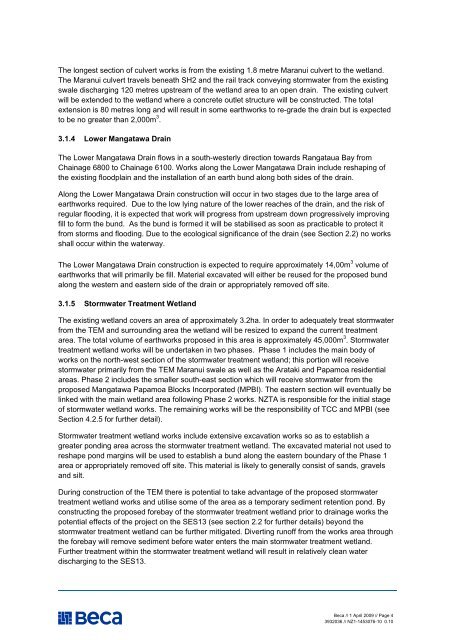2. Mangatawa catchment consents for earthworks, storm water ...
2. Mangatawa catchment consents for earthworks, storm water ...
2. Mangatawa catchment consents for earthworks, storm water ...
- No tags were found...
Create successful ePaper yourself
Turn your PDF publications into a flip-book with our unique Google optimized e-Paper software.
The longest section of culvert works is from the existing 1.8 metre Maranui culvert to the wetland.<br />
The Maranui culvert travels beneath SH2 and the rail track conveying <strong>storm</strong><strong>water</strong> from the existing<br />
swale discharging 120 metres upstream of the wetland area to an open drain. The existing culvert<br />
will be extended to the wetland where a concrete outlet structure will be constructed. The total<br />
extension is 80 metres long and will result in some <strong>earthworks</strong> to re-grade the drain but is expected<br />
to be no greater than 2,000m 3 .<br />
3.1.4 Lower <strong>Mangatawa</strong> Drain<br />
The Lower <strong>Mangatawa</strong> Drain flows in a south-westerly direction towards Rangataua Bay from<br />
Chainage 6800 to Chainage 6100. Works along the Lower <strong>Mangatawa</strong> Drain include reshaping of<br />
the existing floodplain and the installation of an earth bund along both sides of the drain.<br />
Along the Lower <strong>Mangatawa</strong> Drain construction will occur in two stages due to the large area of<br />
<strong>earthworks</strong> required. Due to the low lying nature of the lower reaches of the drain, and the risk of<br />
regular flooding, it is expected that work will progress from upstream down progressively improving<br />
fill to <strong>for</strong>m the bund. As the bund is <strong>for</strong>med it will be stabilised as soon as practicable to protect it<br />
from <strong>storm</strong>s and flooding. Due to the ecological significance of the drain (see Section <strong>2.</strong>2) no works<br />
shall occur within the <strong>water</strong>way.<br />
The Lower <strong>Mangatawa</strong> Drain construction is expected to require approximately 14,00m 3 volume of<br />
<strong>earthworks</strong> that will primarily be fill. Material excavated will either be reused <strong>for</strong> the proposed bund<br />
along the western and eastern side of the drain or appropriately removed off site.<br />
3.1.5 Storm<strong>water</strong> Treatment Wetland<br />
The existing wetland covers an area of approximately 3.2ha. In order to adequately treat <strong>storm</strong><strong>water</strong><br />
from the TEM and surrounding area the wetland will be resized to expand the current treatment<br />
area. The total volume of <strong>earthworks</strong> proposed in this area is approximately 45,000m 3 . Storm<strong>water</strong><br />
treatment wetland works will be undertaken in two phases. Phase 1 includes the main body of<br />
works on the north-west section of the <strong>storm</strong><strong>water</strong> treatment wetland; this portion will receive<br />
<strong>storm</strong><strong>water</strong> primarily from the TEM Maranui swale as well as the Arataki and Papamoa residential<br />
areas. Phase 2 includes the smaller south-east section which will receive <strong>storm</strong><strong>water</strong> from the<br />
proposed <strong>Mangatawa</strong> Papamoa Blocks Incorporated (MPBI). The eastern section will eventually be<br />
linked with the main wetland area following Phase 2 works. NZTA is responsible <strong>for</strong> the initial stage<br />
of <strong>storm</strong><strong>water</strong> wetland works. The remaining works will be the responsibility of TCC and MPBI (see<br />
Section 4.<strong>2.</strong>5 <strong>for</strong> further detail).<br />
Storm<strong>water</strong> treatment wetland works include extensive excavation works so as to establish a<br />
greater ponding area across the <strong>storm</strong><strong>water</strong> treatment wetland. The excavated material not used to<br />
reshape pond margins will be used to establish a bund along the eastern boundary of the Phase 1<br />
area or appropriately removed off site. This material is likely to generally consist of sands, gravels<br />
and silt.<br />
During construction of the TEM there is potential to take advantage of the proposed <strong>storm</strong><strong>water</strong><br />
treatment wetland works and utilise some of the area as a temporary sediment retention pond. By<br />
constructing the proposed <strong>for</strong>ebay of the <strong>storm</strong><strong>water</strong> treatment wetland prior to drainage works the<br />
potential effects of the project on the SES13 (see section <strong>2.</strong>2 <strong>for</strong> further details) beyond the<br />
<strong>storm</strong><strong>water</strong> treatment wetland can be further mitigated. Diverting runoff from the works area through<br />
the <strong>for</strong>ebay will remove sediment be<strong>for</strong>e <strong>water</strong> enters the main <strong>storm</strong><strong>water</strong> treatment wetland.<br />
Further treatment within the <strong>storm</strong><strong>water</strong> treatment wetland will result in relatively clean <strong>water</strong><br />
discharging to the SES13.<br />
Beca // 1 April 2009 // Page 4<br />
3932036 // NZ1-1453076-10 0.10
















